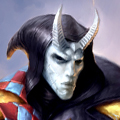 DanceOfSlaanesh wrote:
DanceOfSlaanesh wrote:From a theoretical point of view, if you want a natural looking shading, like the model is standing outside in natural light, I would say the cloak would become a little bit darker towards the bottom. But if the surface it is standing on is reflective, the bounced light could make it lighter even.
Neither is wrong or right I would say.
For my preference, I like bright miniatures so I would just shade strictly in the deepest recesses and not do an all over wash.
Hmmm okay, I understand that. Most cloaks I see in tutorials have larger ripples, fewer ripples, so it's a little easier to understand the lighting. These have been deceptively tricky. I thought they'd be good beginner units. There are some very fine ripples and the cloaks flare out a bit at the end. Trying to rectify that has been tough.
I'm getting the sense that an all over wash won't work for this. I'll experiment a little bit off of what you said.
One thing I'm trying is a very, very dark brown as the base (a wash over black primer) then dry brushing bright white over it. Then gradually build up with very thin layers (with an airbrush). The first layer seemed pretty promising, which would make my shade question irrelevant!